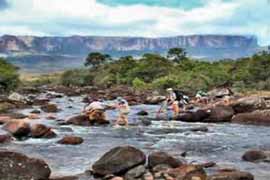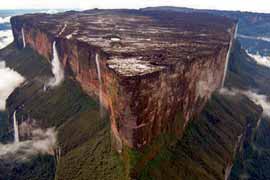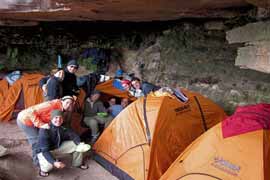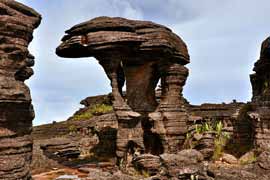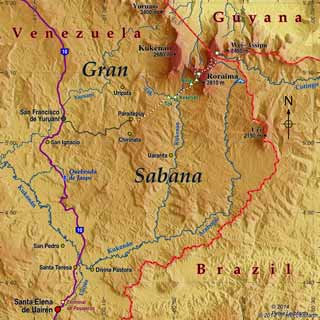Mount Roraima (in the Pemón language Roraima tepui, Roroi means “blue-green” and ma means “great”, tepui means “house of spirits”) is one of the 115 tepuis in the Gran Sabana. It is the highest of the Pakaraima chain of tepui plateau in South America and includes the triple border point of Venezuela, Brazil and Guyana. Mount Roraima lies on the Guiana Shield in the southeastern corner of Venezuela's 30,000 km² Canaima National Park forming the highest peak of Guyana's Highland Range. The tabletop mountains of the park are considered some of the oldest geological formations on Earth, dating back to some two billion years ago in the Precambrian.
The mountain's highest point is Maverick Rock, 2810 m, and its 31 km² summit area is defended by 400-metre-tall cliffs on all sides. The landscape on the high table is a rock labyrinth with many gorges – sometimes several hundred feet deep – no flat plateau, as was previously thought. The climate is humid and tropical at the bottom (~30°C), while on top of the plateau it is rather moderate (~10°C) with different weather conditions. It rains almost every day of the year.
Many of the species found on Roraima are unique to the plateau. On top of the mountain grow various types of forests with a wide variety of orchid, bromeliad, and carnivorous plant species. The animal diversity consists of insects, birds, toads and also small reptiles and mammals like mices. Reports of the famous South American explorer Sir Robert Hermann Schomburgk inspired the English country doctor Arthur Conan Doyle a novel, The Lost World (1912) about the discovery of a living prehistoric world of dinosaurs and prehistoric plants.
Since long before the arrival of European explorers, the mountain has held a special significance for the indigenous people of the region, and it is central to many of their myths and legends. The Pemón and Kapon natives of the Gran Sabana see Mount Roraima as the stump of a mighty tree that once held all the fruits and tuberous vegetables in the world. Felled by Makunaima, their mythical trickster, the tree crashed to the ground, unleashing a terrible flood. The local Indians never attempted to climb the Roraima tepui.
Trekking on Mount Roraima
Today, Mount Roraima is a destination for backpackers. Almost all who go up the mountain approach it from the Venezuelan side. Most hikers hire a Pemón Indian guide in the village of Paraitepui, which is reached by dirt road from the main Gran Sabana road between kilometre 88 and Santa Elena de Uairén. Although the path to reach the plateau is well marked and popularly traveled, it is easy to get lost on top of the mountain, as there are few distinct trails and the near constant cloud cover on top and the uncanny rock formations make visual references problematic. Paraitepui can be reached easily by four-wheel-drive vehicle, with great difficulty by car if the unpaved road conditions are unusually fine, or by foot in about a day.
From Paraitepui, most hikers take one day to reach the base of the mountain, and then another day to follow “La Rampa” a natural staircase-like path, up to the top. Another two days are typically needed for the return, and many people spend one day and night on top of the mountain, making five days in total. Longer treks can reach the northern portion of the tepui, mostly in Guyana, with less explored and more intriguing sites such as Lake Gladys, although this offers more dangers than its more popular southern part and should only be attempted by well-supplied groups. The less adventurous can also reach the mountain, weather permitting, by helicopter tours available from the nearby Venezuelan city of Santa Elena de Uairén.



